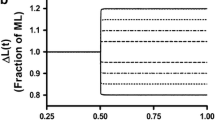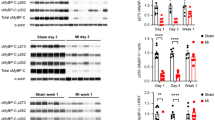Abstract
Following activation by G-protein-coupled receptor agonists, protein kinase C (PKC) modulates cardiac myocyte function by phosphorylation of intracellular targets including myofilament proteins cardiac troponin I (cTnI) and cardiac myosin binding protein C (cMyBP-C). Since PKC phosphorylation has been shown to decrease myofibril ATPase activity, we hypothesized that PKC phosphorylation of cTnI and cMyBP-C will lower myocyte power output and, in addition, attenuate the elevation in power in response to protein kinase A (PKA)-mediated phosphorylation. We compared isometric force and power generating capacity of rat skinned cardiac myocytes before and after treatment with the catalytic subunit of PKC. PKC increased phosphorylation levels of cMyBP-C and cTnI and decreased both maximal Ca2+ activated force and Ca2+ sensitivity of force. Moreover, during submaximal Ca2+ activations PKC decreased power output by 62 %, which arose from both the fall in force and slower loaded shortening velocities since depressed power persisted even when force levels were matched before and after PKC. In addition, PKC blunted the phosphorylation of cTnI by PKA, reduced PKA-induced spontaneous oscillatory contractions, and diminished PKA-mediated elevations in myocyte power. To test whether altered thin filament function plays an essential role in these contractile changes we investigated the effects of chronic cTnI pseudo-phosphorylation on myofilament function using myocyte preparations from transgenic animals in which either only PKA phosphorylation sites (Ser-23/Ser-24) (PP) or both PKA and PKC phosphorylation sites (Ser-23/Ser-24/Ser-43/Ser-45/T-144) (All-P) were replaced with aspartic acid. Cardiac myocytes from All-P transgenic mice exhibited reductions in maximal force, Ca2+ sensitivity of force, and power. Similarly diminished power generating capacity was observed in hearts from All-P mice as determined by in situ pressure–volume measurements. These results imply that PKC-mediated phosphorylation of cTnI plays a dominant role in depressing contractility, and, thus, increased PKC isozyme activity may contribute to maladaptive behavior exhibited during the progression to heart failure.







Similar content being viewed by others
References
Aiello EA, Cingolani HE (2001) Angiotensin II stimulates cardiac L-type calcium currents by a calcium and protein kinase C-dependent mechanism. Am J Physiol Heart Circ Physiol 280:H1528–H1536
Belin RJ, Sumandea MP, Allen EJ, Schoenfelt K, Wang H, Solaro RJ, de Tombe PP (2007) Augmented protein kinase C-alpha-induced myofilament protein phosphorylation contributes to myofilament dysfunction in experimental congestive heart failure. Circ Res 101:195–204
Bilchick KC, Duncan JG, Ravi R, Takimoto E, Champion HC, Gao WD, Stull LB, Kass DA, Murphy AM (2007) Heart failure-associated alterations in troponin I phosphorylation impair ventricular relaxation-afterload and force-frequency responses and systolic function. Am J Physiol 292:H318–H325
Bodor GS, Oakeley AE, Allen PD, Crimmins DL, Ladenson JH, Anderson PA (1997) Troponin I phosphorylation in the normal and failing adult human heart. Circulation 96:1495–1500
Bowling N, Walsh R, Song G, Estridge T, Sandusky G, Fouts R, Mintze K, Pickard T, Roden R, Bristow M, Sabbah H, Mizrahi J, Gromo G, King G, Vlahos C (1999) Increased protein kinase C activity and expression in Ca2+-sensitive isoforms in the failing human heart. Circulation 1999:384–391
Bowman JC, Steinberg SF, Jiang T, Geenen DL, Fishman GI, Buttrick PM (1997) Expression of protein kinase C beta in the heart causes hypertrophy in adult mice and sudden death in neonates. J Clin Investig 100:2189–2195
Braz JC, Gregory K, Pathak A, Zhao W, Sahin B, Klevitsky R, Kimball TF, Lorenz JN, Nairn AC, Liggett SB, Bodi I, Wang S, Schwartz A, Lakatta EG, DePaoli-Roach AA, Robbins J, Hewett TE, Bibb JA, Westfall MV, Kranias EG, Molkentin JD (2004) PKC-alpha regulates cardiac contractility and propensity toward heart failure. Nat Med 10:248–254
Dorn GW, Force T (2005) Protein kinase cascades in the regulation of cardiac hypertrophy. J Clin Investig 115:527–537
Endoh M, Blinks JR (1988) Actions of sympathomimetic amines on the Ca2+ transients and contractions of rabbit myocardium: reciprocal changes in myofibrillar responsiveness to Ca2+ mediated through—and β-adrenoceptors. Circ Res 62:247–265
Fabiato A (1988) Computer programs for calculating total from specified free or free from specified total ionic concentrations in aqueous solutions containing multiple metals and ligands. Methods Enzymol 157:378–417
Goldspink PH, Montgomery DE, Walker LA, Urboniene D, McKinney RD, Geenen DL, Solaro RJ, Buttrick PM (2004) Protein kinase C epsilon overexpression alters myofilament properties and composition during the progression of heart failure. Circ Res 95:424–432
Gray MO, Zhou H-Z, Schafhalter-Zoppoth I, Zhu P, Mochly-Rosen D, Messing RO (2004) Preservation of base-line hemodynamic function and loss of inducible cardioprotection in adult mice lacking protein kinase C-epsilon. J Biol Chem 279:3596–3604
Gu X, Bishop SP (1994) Increased protein kinase C and isozyme redistribution in pressure-overloaded cardiac hypertrophy in the rat. Circ Res 75:1218–1223
Hahn HS, Marreez Y, Odley A, Sterbling A, Yussman MG, Hitty KC, Bodi I, Liggett SB, Schwartz A, Dorn GW (2003) Protein kinase C alpha negatively regulates systolic and diastolic function in pathological hypertrophy. Circ Res 93:1111–1119
Hanft LM, McDonald KS (2009) Sarcomere length dependence of power output is increased after PKA treatment in rat cardiac myocytes. Am J Physiol 296:H1524–H1531
Herron TJ, Korte FS, McDonald KS (2001) Power output is increased after phosphorylation of myofibrillar proteins in rat skinned cardiac myocytes. Circ Res 89:1184–1190
Hidalgo C, Hudson B, Bogomolovas J, Zhu Y, Anderson B, Greaser ML, Labeit S, Granzier H (2009) PKC phosphorylation of titin’s PEVK element: a novel and conserved pathway for modulating myocardial stiffness. Circ Res 105:631–638
Huang X, Pi Y, Lokuta AJ, Greaser ML, Walker JW (1997) Arachidonic acid stimulates protein kinase C-epsilon redistribution in heart cells. J Cell Sci 110:1625–1634
Huang L, Wolska BM, Montgomery DE, Burkart EM, Buttrick PM, Solaro RJ (2001) Increased contractility and altered calcium transients of mouse heart myocytes conditionally expressing PKC-beta. Am J Physiol Cell Physiol 280:C1114–C1120
Inagaki K, Hahn HS, Dorn GW, Mochly-Rosen D (2003) Additive protection of the ischemic heart ex vivo by combined treatment with delta-protein kinase C inhibitor and epsilon-protein kinase C activator. Circulation 108:869–875
Jideama NM, Noland TA, Raynor RL, Blobe GC, Fabbro D, Kazanietz MG, Blumberg PM, Hannum YA, Kuo JF (1996) Phosphorylation specificities of protein kinase C isozymes for bovine cardiac troponin I and troponin T and sites within these proteins and regulation of myofilament properties. J Biol Chem 271:23277–23283
Kirk JA, MacGowan GA, Evans C, Smith SH, Warren CM, Mamidi R, Chandra M, Stewart AFR, Solaro RJ, Shroff SV (2009) Left ventricular and myocardial function in mice expressing constitutively pseudophosphorylated cardiac troponin I. Circ Res 105:1232–1239
McDonald KS (2000) Ca2+ dependence of loaded shortening in rat skinned cardiac myocytes and skeletal muscle fibers. J Physiol 525:169–181
Messer AE, Jacques AM, Marston SB (2007) Troponin phosphorylation and regulatory function in human heart muscle: dephosphorylation of Ser 23/24 on troponin I could account for the contractile defect in end-stage heart failure. J Mol Cell Cardiol 42:247–259
Mochly-Rosen D, Wu G, Hahn H, Osinska H, Liron T, Lorenz JN, Yantani A, Robbins J, Dorn GW (2000) Cardiotrophic effects of protein kinase C epsilon: analysis by in vivo modulation of PKC-epsilon translocation. Circ Res 86:1173–1179
Nishizuka Y (1995) Protein kinase C and lipid signaling for sustained cellular responses. FASEB J 9:484–496
Noguchi T, Hunlich M, Camp PC, Begin KJ, El-Zaru M, Patten R, Leavitt BJ, Ittleman FP, Alpert NR, LeWinter MM, VanBuren P (2004) Thin filament-based modulation of contractile performance in human heart failure. Circulation 110:982–987
Noland JR, Kuo TA (1991) Protein kinase C phosphorylation of cardiac troponin I or troponin T inhibits Ca2+-stimulated actomyosin MgATPase activity. J Biol Chem 266:4974–4978
Noland JR, Kuo TA (1993) Protein kinase C phosphorylation of cardiac troponin T decreased Ca2+-dependent actomyosin MgATPase and troponin T binding to tropomyosin F-actin complex. Biochem J 288:2705–2711
Noland JR, Guo X, Raynor RL, Jedeama NM, Avery-Hart-Fullard V, Solaro RJ, Kuo JF (1995) Cardiac troponin I mutants. Phosphorylation by protein kinases C and A and regulation of Ca2+-stimulated MgATPase of reconstituted actomyosin S-1. J Biol Chem 43:25445–25454
Pi Y, Walker JW (2000) Diacylglycerol and fatty acids synergistically increase cardiomyocyte contraction via activation. Am J Physiol 279:H26–H34
Pi Y, Zhang D, Kemnitz KR, Wang H, Walker JW (2003) Protein kinase C and A sites on troponin I regulate myofilament calcium sensitivity and ATPase activity in the mouse myocardium. J Physiol 552:845–857
Puceat M, Clement O, Lechene P, Pelosin JM, Ventura-Clapier R, Vassort G (1990) Neurohormonal control of calcium sensitivity of myofilaments in rat single heart cells. Circ Res 67:517–524
Qui Y, Ping P, Tang XL, Manchikalapudi S, Rizvi A, Zhang J, Takano H, Wu WJ, Teschner S, Bolli R (1998) Direct evidence that protein kinase C plays an essential role in the development of late preconditioning against myocardial stunning in conscious rabbits and that epsilon is the isoform involved. J Clin Investig 101:2182–2198
Sakthivel S, Finley NL, Rosevear PR, Lorenz JN, Gulick J, Kim S, VanBuren P, Martin LA, Robbins J (2005) In vivo an in vitro analysis of cardiac troponin I phosphorylation. J Biol Chem 280:703–714
Scruggs SB, Hinken AC, Thawornkaiwong A, Robbins J, Walker LA, de Tombe PP, Geenen DL, Buttrick PM, Solaro RJ (2009) Ablation of ventricular myosin regulatory light chain phosphorylation in mice causes cardiac dysfunction in situ and affects neighboring myofilament protein phosphorylation. J Biol Chem 284:5097–5106
Strasser RH, Briem SK, Vahl CF, Lange R, Hagl S, Kubler W (1996) Selective expression of cardiac protein kinase C-isoforms in chronic heart failure. Circulation 94(suppl I):I–551
Sumandea MP, Pyle WG, Kobayashi T, deTombe PP, Solaro RJ (2003) Identification of a functionally critical PKC phosphorylation residue of cardiac troponin T. J Biol Chem 278:35135–35144
Takeishi T, Ping P, Bolli R, Kirkpatrick DL, Hoit BD, Walsh RA (2000) Transgenic overexpression of constitutively active protein kinase C epsilon causes concentric cardiac hypertrophy. Circ Res 86:1218–1223
Terzic A, Puceat M, Clement O, Scamps F, Vassort G (1992) Alpha-1 adrenergic effects on intracellular pH and calcium and on myofilaments in single rat cardiac cells. J Physiol 447:275–292
Van der Velden J, Narolska NA, Lamberts RR, Boontje NM, Borbely A, Zaremba R, Bronzwaer JG, Papp Z, Jaquet K, Paulus WJ, Stienen GJ (2006) Functional effects of protein kinase C-mediated myofilament phosphorylation in human myocardium. Cardiovasc Res 69:876–887
Venema R, Kuo JF (1993) Protein kinase C-mediated phosphorylation of troponin I and C-protein in isolated myocardial cells is associated with inhibition of myofibrillar actomyosin MgATPase. J Biol Chem 268:2705–2711
Vlahos CJ, McDowell SA, Clerk A (2003) Kinases as therapeutic targets for heart failure. Nat Rev 2:99–113
Wakasaki H, Koya D, Schoen FJ, Jirousek MR, Ways DK, Hoit BD, Walsh RA, King GL (1997) Targeted overexpression of protein kinase C beta2 isoform in myocardium causes cardiomyopathy. Proc Natl Acad Sci USA 94:2189–2195
Zhang ZH, Johnson JA, Chen L, El-Sherif N, Mochly-Rosen D, Boutjdir M (1997) C2 region-derived peptides of beta-protein kinase regulate cardiac calcium channels. Circ Res 80:720–729
Acknowledgments
The authors would like to acknowledge the late Dr. Jeffrey W. Walker for insightful and poignant discussion related to the PKC effects on cardiac myocyte biology. This work was supported by an American Heart Association (Heartland Affiliate) Postdoctoral Fellowship (0825725G) to L.M.H. a National Heart, Lung, and Blood Institute grant (R01-HL-57852) to K.S.M., (P01 HL 062426) to R.J.S., and (T32 HL 07692) to A.C.H. and S.B.S.
Author information
Authors and Affiliations
Corresponding author
Rights and permissions
About this article
Cite this article
Hinken, A.C., Hanft, L.M., Scruggs, S.B. et al. Protein kinase C depresses cardiac myocyte power output and attenuates myofilament responses induced by protein kinase A. J Muscle Res Cell Motil 33, 439–448 (2012). https://doi.org/10.1007/s10974-012-9294-9
Received:
Accepted:
Published:
Issue Date:
DOI: https://doi.org/10.1007/s10974-012-9294-9




